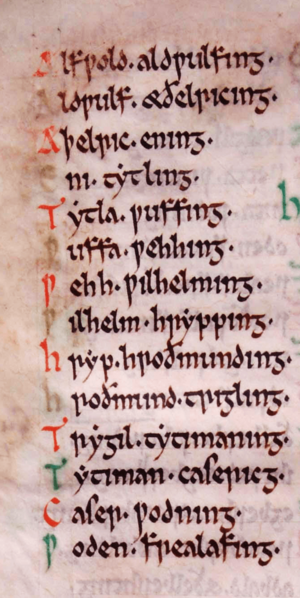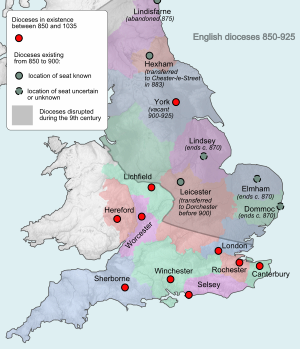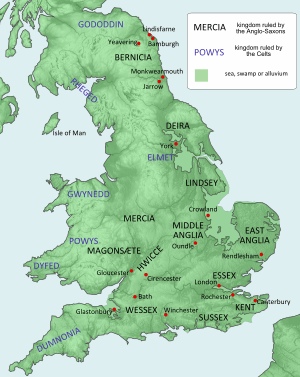Ealdwulf of East Anglia facts for kids
Quick facts for kids Ealdwulf |
|
|---|---|
| King of the East Angles | |
| Reign | c. 664 – 713 |
| Predecessor | Æthelwold |
| Successor | Ælfwald |
| Died | 713 |
| Issue | Ælfwald Ecgburga |
| Dynasty | Wuffingas |
| Father | Æthilric |
| Mother | Hereswith |
| Religion | Christian |
Ealdwulf was the King of East Anglia from about 664 to 713. He was the son of Hereswitha, a princess from Northumbria, and Æthilric. His uncles had also ruled East Anglia before him. Ealdwulf remembered seeing a special temple when he was very young. This temple belonged to his ancestor, Rædwald, and had both Christian and pagan altars.
Ealdwulf ruled for a very long time, about 49 years. This long period shows that his kingdom was stable and strong. During his time as king, East Anglia grew and became more successful. Its main trading center, Gipeswic (which is now Ipswich), became very important. Also, East Anglia started making its own coins for the first time. The church area, called a diocese, in East Anglia was also divided. A new church center was set up at Helham, likely North Elmham in Norfolk. Ealdwulf and his queen had at least two children. His son, Ælfwald, became king after him in 713. Ælfwald was the last king from the Wuffingas family to rule East Anglia.
Contents
Ealdwulf's Early Life
The independent kingdom of East Anglia was ruled by the Wuffingas family until 749. This family was named after Wuffa, who was the grandfather of King Raedwald. The family tree of the Wuffingas kings is found in an old book called the Anglian collection. Ealdwulf's name is listed near the top of the East Anglian kings in this book.
A monk named Bede from Northumbria wrote that Hereswitha was Ealdwulf's mother. We don't know much about her before she married into the East Anglian royal family. We do know she was the daughter of a nephew of Edwin of Northumbria. Ealdwulf's father, Æthilric, was the son of Eni, who was Raedwald's brother. Æthilric's three brothers all became kings of East Anglia.
Bede also wrote that Ealdwulf remembered seeing a temple when he was a boy. This temple had both Christian and pagan altars, which were kept by King Rædwald. This temple is the only building we know of that was connected to the Wuffingas royal family. Rædwald had become a Christian, but his pagan wife convinced him to also keep his old beliefs. So, he built a Christian altar inside his wife's pagan temple.
Ealdwulf's father died around 647. After this, his mother Hereswitha traveled to Gaul (modern-day France). She went there to live a religious life at a royal church called Chelles. This suggests that there were no religious places for women in East Anglia at that time.
Ealdwulf's Time as King
Ealdwulf became king in about 664, taking over from his uncle Æthelwold of East Anglia. Old family records don't show that Æthelwold had any sons to become king after him. Ealdwulf was the last East Anglian ruler that Bede wrote about. Bede mentioned him in his book, Ecclesiastical History of the English People, saying Ealdwulf was in his 17th year as king in 680. We don't know many details about his rule, except that he was king for 49 years.
During the 660s, a serious plague spread across the Anglo-Saxon kingdoms. At one point, only Boniface, the bishop of the East Anglian church area of Dommoc, was left. He was the only English bishop whose religious authority came from Canterbury.
Bisi, who was the bishop of the East Angles, became ill and could no longer do his job. Because of this, the archbishop of Canterbury, Theodore of Tarsus, decided to divide Bisi's church area. He created a second East Anglian church center at Helmham, which is thought to be North Elmham or South Elmham. Two new bishops were chosen: Æcci for Dommoc and Baduwine for Elmham.
Coins and Trade
The first coins made in East Anglia were created during Ealdwulf's rule. The use of English coins started in Kent, with gold shillings made in the 660s and 670s. Later, these coins became less valuable as the amount of gold in them decreased. They were replaced by silver coins called sceattas or pennies. These coins have been found in important places across East Anglia. These areas include Hunstanton, Thetford, the edge of the Fens, Burgh Castle, and around Rendlesham and Ipswich.
These coins were not yet used as a full currency, and they didn't always clearly show who the king was. The coins made in East Anglia are often found with coins from Kent, East Saxon areas, and places like the Netherlands. This shows that East Anglia traded with these other regions. Gipeswic (Ipswich) grew a lot during this time. Its port expanded, and it became known for making a type of pottery called Ipswich Ware. This pottery was inspired by designs from Frisia. Gipeswic likely traded with cities like Domburg and Dorestad in the Netherlands. This trade route became even more important as Christian missionaries traveled to Frisia in the 680s.
Important Relationships
In 693, Pope Sergius sent a letter to Ealdwulf, along with Æthelred of Mercia and Aldfrith of Northumbria. The Pope asked them to accept Berhtwald as the new Archbishop of Canterbury.
Towards the end of Ealdwulf's reign, the rule of Ceolred of Mercia was causing problems. A religious leader named Boniface criticized Ceolred for his behavior and for not respecting the church. At this time, a Mercian religious hermit named Guthlac lived on an island in the fenlands called Crowland. His quiet home became a safe place for Æthelbald, who was trying to become king of Mercia. It seems that important people from East Anglia helped and protected Æthelbald there.
Family Life and End of Reign
We do not know the name of Ealdwulf's queen. They had at least two children: his son and heir, Ælfwald, and a daughter named Ecgburga, who became an abbess (a leader of a group of nuns). We can assume that Ealdwulf and his family were Christians throughout their lives.
According to old records from Francia, Ealdwulf died in 713. His son, Ælfwald, became king after him and ruled until 749. After Ælfwald, kings from different families took over. Historians are not sure why this change happened.




